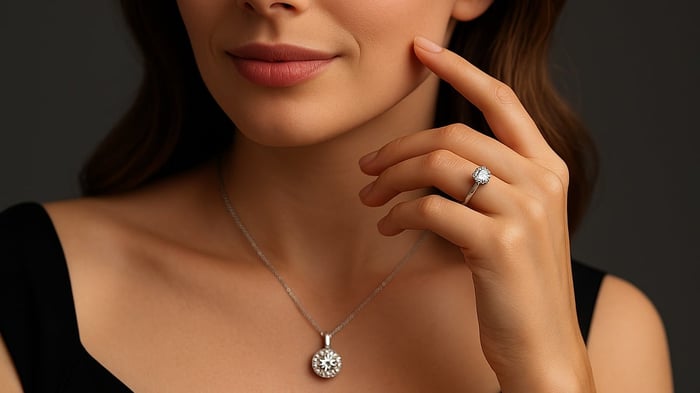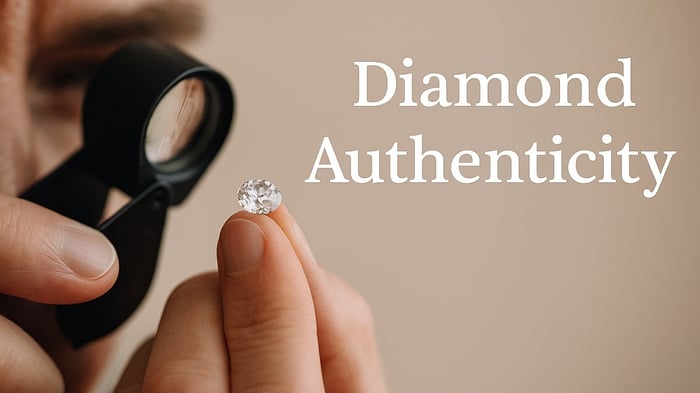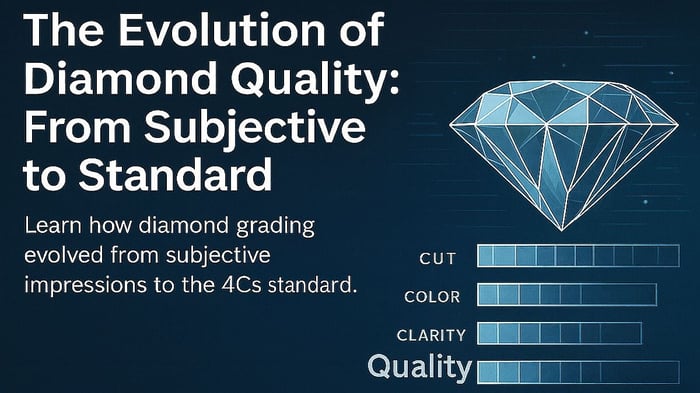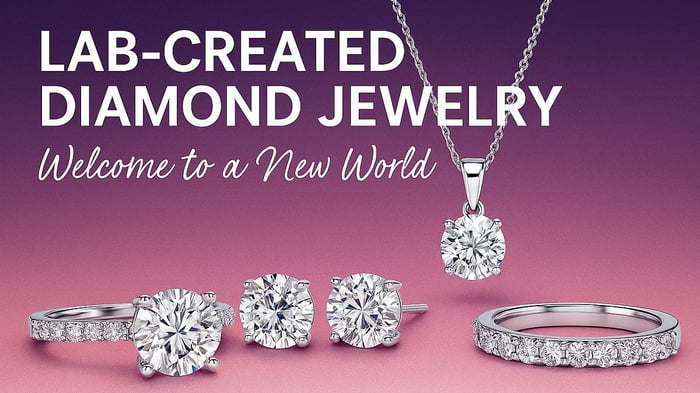Table of Contents
Lab-grown vs. natural diamonds, an issue that is on the mind of a large proportion of people choosing real diamond jewelry. Both types of diamond are, in many ways, the same — and yet intriguingly different.
Natural diamonds form deep within the Earth’s mantle, under immense heat and pressure over billions of years. For centuries, they were nature’s exclusive treasure — rare, coveted, and shrouded in mystique. Today, those same conditions are replicated in laboratories using advanced techniques such as High Pressure, High Temperature (HPHT) and Chemical Vapor Deposition (CVD). The result? Lab-grown diamonds with the same chemical composition, brilliance, and hardness as mined stones.
Yet subtle differences exist: trace elements like nitrogen or silicon, metallic inclusions, or how a diamond reacts under UV light. These details, invisible to the naked eye, are what gemologists rely on to tell them apart.
This article explores how both deep-mined and lab-grown diamonds are created, how experts distinguish between them, and what each option means for buyers who value beauty, ethics, and science.
Key Takeaways
Lab-grown diamonds are made from the same material as natural diamonds and share identical physical and chemical properties.
They are created using HPHT or CVD processes that replicate natural geological conditions.
Advanced testing — including conductivity, magnetic, and UV response — can identify a diamond’s origin.
Lab-grown diamonds offer the same sparkle and durability at a significantly lower price and with far fewer ethical concerns.
18ctw Lab Grown Diamond Tennis Bracelet D/VVS Quality Set in 14k Yellow Gold
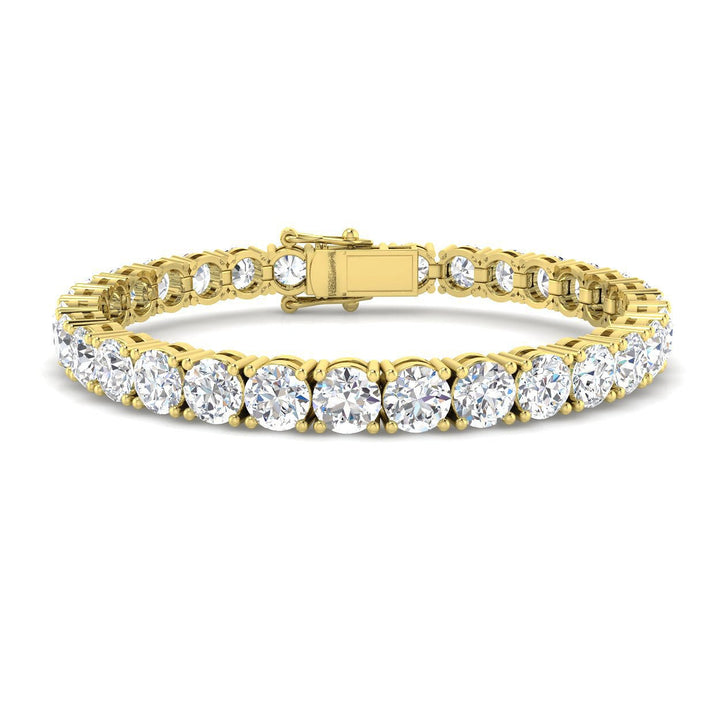
$6,995.00
$16,195.00
Experience unrivalled sophistication with this stunning Lab Diamond Tennis Bracelet, set in 14k Yellow Gold. The beautifully aligned 5.4mm diameter round lab-grown diamonds weigh a total of 18ct and radiate a captivating glow. The diamonds are of D/VVS quality. Bearing… read more
Understanding Lab-Grown Diamonds
Lab-grown diamonds, sometimes called synthetic or cultured diamonds, are not imitation stones — they are real diamonds. They share the same atomic structure, optical brilliance, and hardness as mined ones.
They can even be grown in a dazzling range of colors, from colorless to fancy shades like pink, blue, and yellow. Through precise control of the growth environment, scientists can fine-tune hue and clarity in ways that nature never could.
The main advantages include:
Ethical sourcing. No mining means no conflict diamonds, unsafe labor conditions, or ecosystem destruction.
Affordability. Lab-grown diamonds are typically 30–50% less expensive than mined stones of equivalent quality.
Sustainability. Producing lab-grown diamonds uses far less water, energy, and land than mining operations.
This combination of ethics, value, and beauty is driving a generational shift — particularly among younger buyers who want their purchases to reflect their values.
A 2025 survey by The Knot found that over 60% of Gen Z couples now choose lab-grown diamonds for their engagement rings. Most cite transparency and sustainability as top reasons.
Lab Grown Diamond Huggie Hoop Children Earrings 0.08ctw in 925 Silver
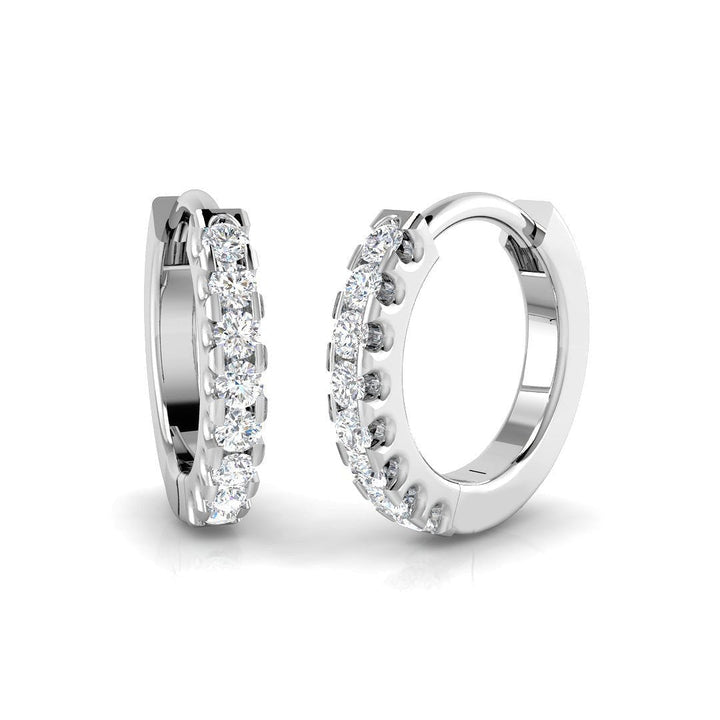
$170.00
$345.00
The Lab Diamond Huggie Hoop Children Earrings are charming and elegant, perfect for young ones. These dainty earrings feature a total diamond weight of 0.08ct, ensuring a subtle yet captivating sparkle. They boast a claw setting in premium 925 silver… read more
Methods of Creation
Diamonds created in laboratories are born through two primary methods:
HPHT (High Pressure, High Temperature): Carbon is placed under immense pressure and heat, mimicking the natural conditions found deep within the Earth. The process can produce diamonds within weeks instead of millennia.
CVD (Chemical Vapor Deposition): A thin slice of diamond “seed” is placed in a chamber filled with carbon-rich gases, such as methane. The gases are energized, and carbon atoms accumulate layer by layer, forming a diamond crystal over time.
Each method has its advantages. HPHT produces stones faster and often with exceptional clarity, while CVD offers greater control over size, purity, and color.
By contrast, mined diamonds carry a sense of geological romance — each one a product of billions of years of natural formation. However, extracting them can come with environmental costs: deforestation, soil erosion, and large-scale energy use.
Magnetic Properties and Inclusions
One subtle way gemologists distinguish lab-grown diamonds is by examining their inclusions — tiny internal features that reveal how the stone was formed.
HPHT diamonds may contain metallic inclusions (nickel, cobalt, or iron) from the growth process. These can sometimes make the stone faintly magnetic. Natural diamonds, meanwhile, may contain minerals like garnet or olivine — remnants of their deep-earth birthplace.
This doesn’t affect beauty or durability but does provide clues for trained professionals using magnets or microscopes.
Lab Grown Diamond Channel Set Bangle 3.00ctw in D/VVS 18k White Gold
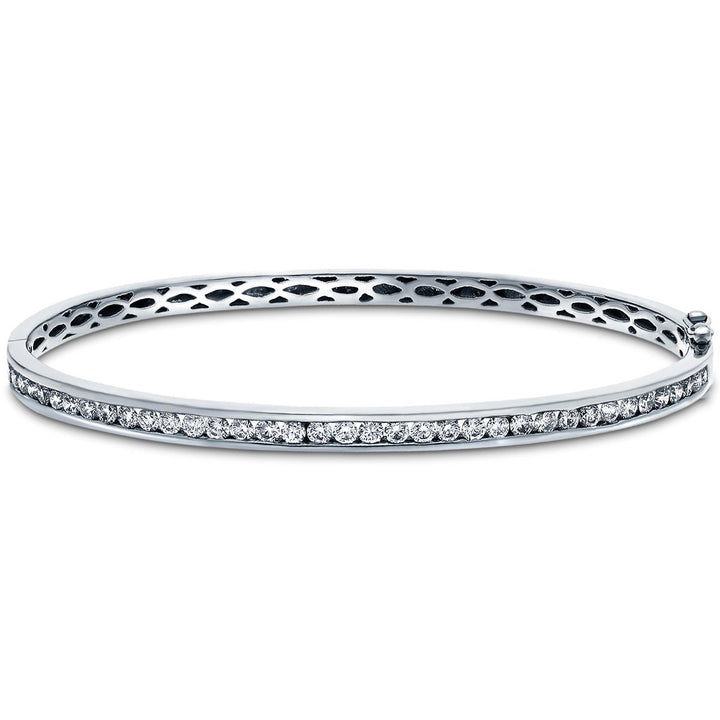
$4,380.00
$10,805.00
Introducing the epitome of elegance: the Lab Diamond Channel Set Bangle, featuring a breathtaking 3.00ctw of real diamonds in a sleek, modern design. Each diamond is meticulously channel-set within a band of lustrous 18k white gold, measuring 5.0mm in width,… read more
Diamond Testing Techniques
Modern technology allows experts to tell lab-grown from natural diamonds with incredible precision. Common testing methods include:
Thermal conductivity tests – Since diamonds are superb heat conductors, these devices measure how quickly heat moves through the stone. Variations can hint at the origin.
Electrical conductivity – Some HPHT diamonds conduct electricity due to trace metals, while most natural stones do not.
Phosphorescence – HPHT-grown diamonds sometimes emit an orange glow when exposed to UV light.
UV absorption and fluorescence – Natural diamonds often glow blue under long-wave UV; lab-grown diamonds tend to respond to short-wave UV.
Advanced imaging – High-resolution instruments, such as the GIA iD100 or De Beers SYNTHdetect, can visualize growth patterns and identify lab-grown stones with over 99% accuracy.
For consumers, this testing ensures confidence and transparency — especially when buying higher-value pieces. Always check that your diamond includes a grading certificate from a recognized lab such as GIA or IGI.
Fluorescence and UV Testing
Fluorescence — a diamond’s reaction to ultraviolet light — remains one of the most reliable identifiers.
Lab-grown diamonds often display stronger reactions under shortwave UV, while natural stones show more response under longwave UV. Under magnification, these reactions create distinct growth patterns — a sort of “fingerprint” that reveals the stone’s origin.
This is one reason major jewelers now use automated screening machines before diamonds are set in jewelry, ensuring accurate labeling and complete consumer confidence.
Pave Set Lab Grown Diamond Paperclip Pendant Necklace 0.70ctw in 14k White Gold
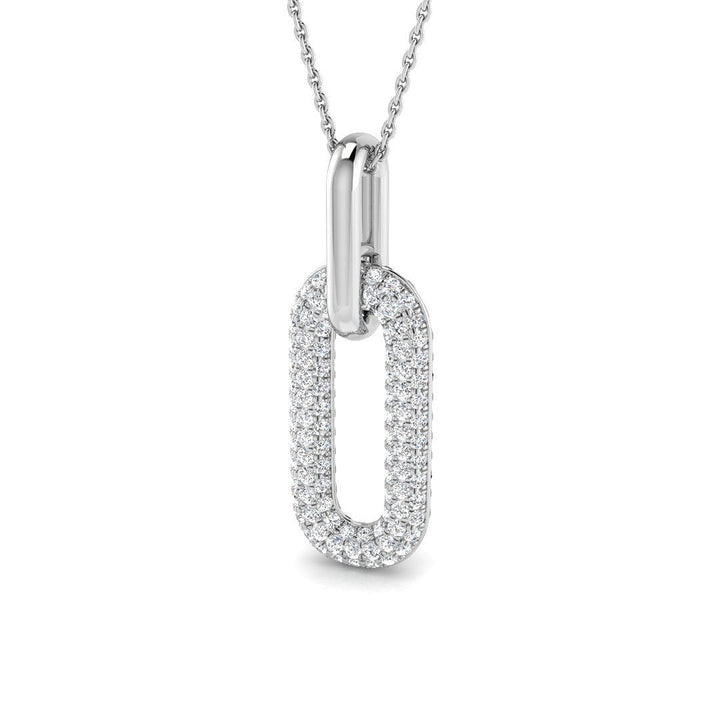
$785.00
$1,495.00
Indulge in the sophistication of the Pave Set Lab Diamond Paperclip Pendant Necklace, a masterpiece of modern design. This exquisite necklace features 0.70ctw of genuine diamonds, meticulously pave set into the innovative loop design. Crafted from premium 14k white gold,… read more
Real-World Insight: A Tale of Two Stones
Consider this true-to-life example:
Amelia, an environmental scientist from California, chose a lab-grown diamond for her engagement ring. Her 1.25-carat stone, certified by IGI, cost roughly $3,800 — almost half what a mined equivalent would have been. She later told friends, “It felt good knowing no one had to dig up half a hillside for my ring.”
In contrast, Michael, a collector and gem enthusiast, purchased a vintage natural diamond ring from the 1920s. For him, the appeal was historical — “It’s a piece of geological time,” he said. His purchase shows that even as technology advances, there’s still emotional resonance in the story behind natural stones.
Both choices are valid — but the ability to choose based on knowledge, rather than marketing, is what empowers today’s buyers.
FAQs About Lab-Grown vs. Natural Diamonds
How long does it take to grow a lab diamond?
Anywhere from 2 to 10 weeks, depending on the method and size of the stone.
Are there durability differences?
None. Both rank 10 on the Mohs scale — the hardest known natural material.
What are the price differences?
Lab-grown diamonds are typically 30–50% less expensive. A 0.5-carat lab-grown solitaire may sell for about $600, compared to $1,000 or more for a mined equivalent.
Can all diamonds be grown?
Yes, most common varieties can. However, some ultra-rare natural colors (like pure red) are still beyond current lab technology.
What are the ethical advantages?
No mining, no exploitation, no conflict zones — and far less environmental disruption.
Lab Grown Diamond Three Stone Drop Earrings 0.70ctw D/VVS in 14k Yellow Gold
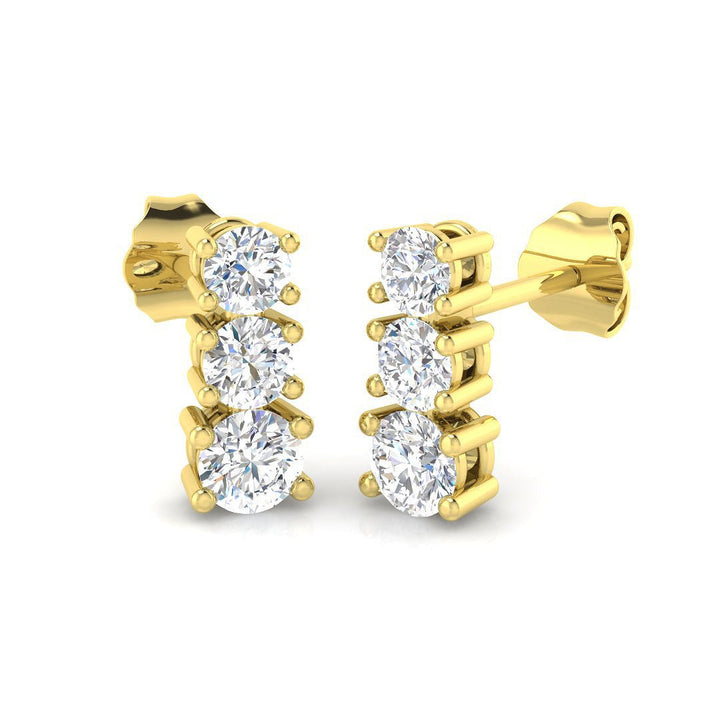
$585.00
$1,195.00
Discover the essence of modern elegance with our Lab Diamond Three Stone Drop Earrings, featuring a total of 0.70ctw D/VVS quality diamonds. Designed and handcrafted in the, these earrings showcase three meticulously set round diamonds cascading beautifully in a delicate… read more
Two Paths to the Same Brilliance
Lab-grown and deep-mined diamonds tell two sides of the same dazzling story. Both offer unmatched sparkle, durability, and symbolic meaning — but they differ in origin, cost, and conscience.
As technology continues to advance, innovations such as AI imaging, blockchain traceability, and automated grading promise even greater trust and transparency in the diamond market.
For modern buyers, lab-grown diamonds offer more than affordability — they represent a mindful way to celebrate love and achievement.
At After Diamonds the question Lab-grown vs, natural diamonds is an easily answered question. What do YOU think?
Discover Lab-Grown Diamond Jewelry
At After Diamonds, we specialize in crafting fine jewelry using real lab-grown diamonds — stones that rival the brilliance of mined gems without the ethical or environmental cost. Each piece is certified, meticulously cut, and designed to last a lifetime.
If you’re ready to explore a more sustainable sparkle, browse our latest collections today.
After Diamonds — where modern luxury meets timeless beauty.
